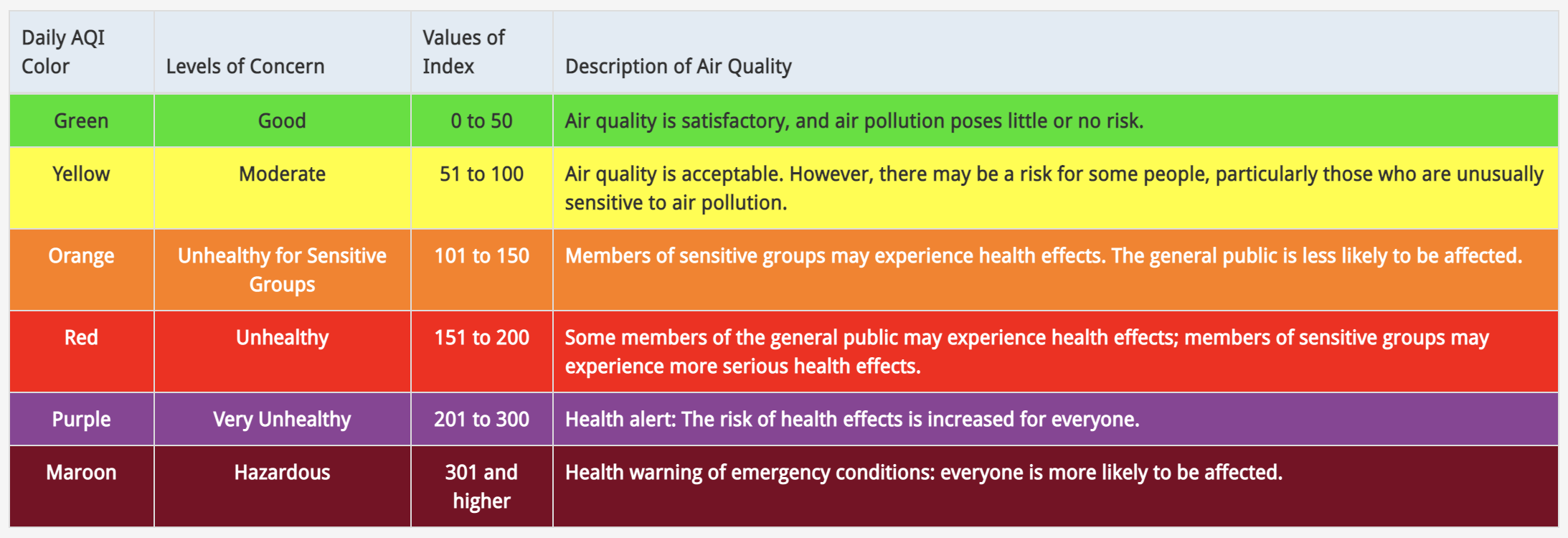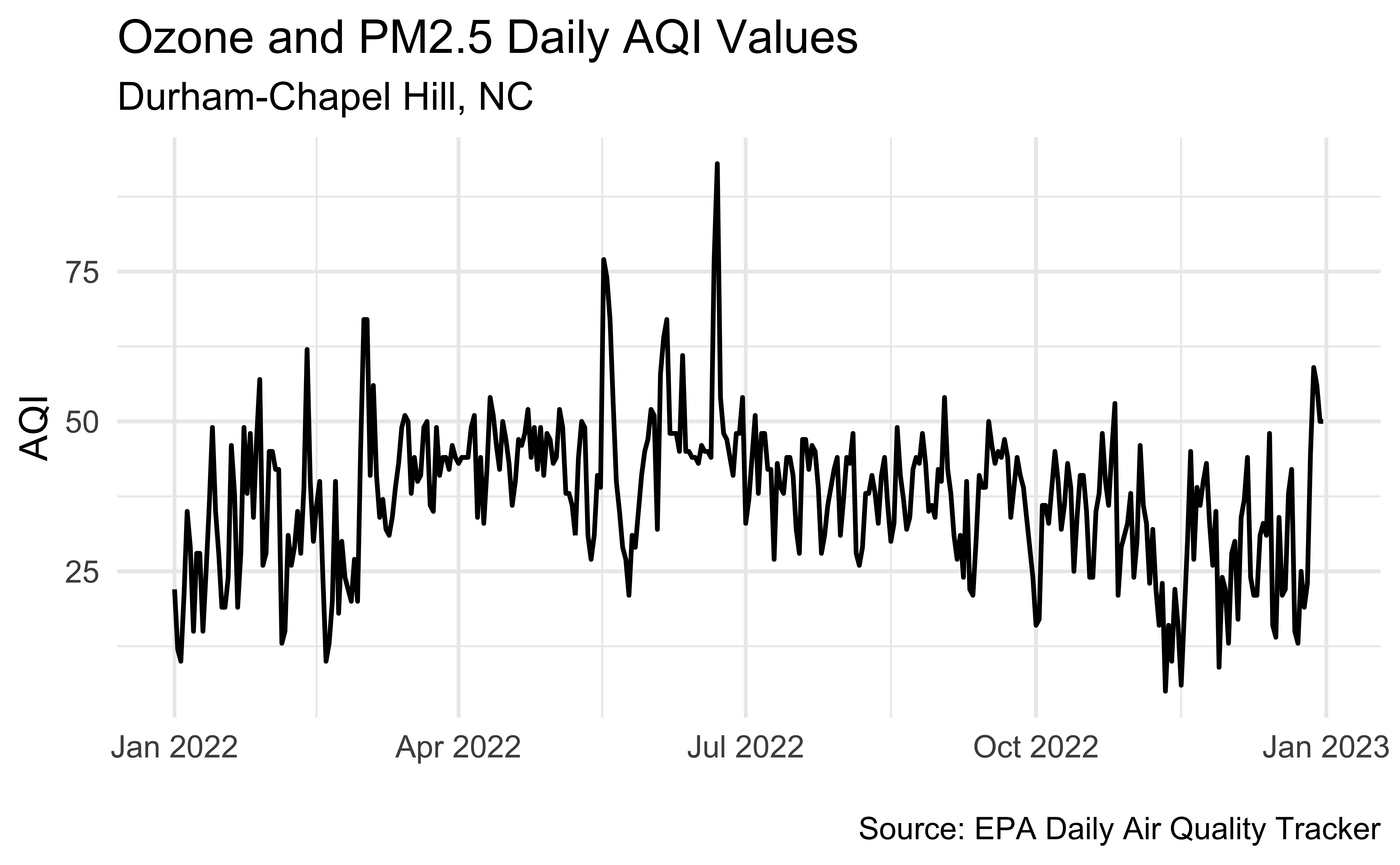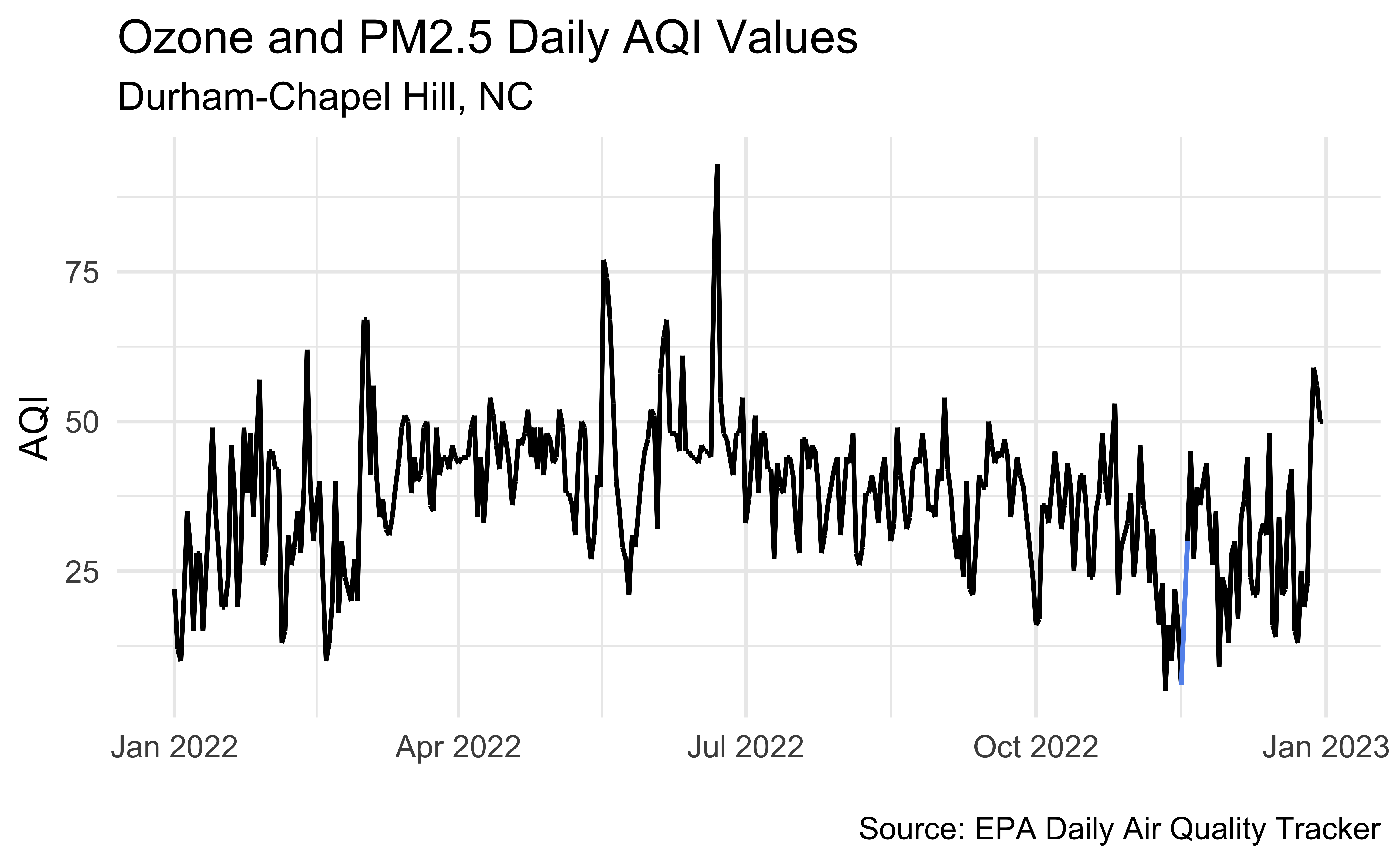# load packages
library(countdown)
library(tidyverse)
library(janitor)
library(colorspace)
library(broom)
library(fs)
# set theme for ggplot2
ggplot2::theme_set(ggplot2::theme_minimal(base_size = 14))
# set figure parameters for knitr
knitr::opts_chunk$set(
fig.width = 7, # 7" width
fig.asp = 0.618, # the golden ratio
fig.retina = 3, # dpi multiplier for displaying HTML output on retina
fig.align = "center", # center align figures
dpi = 300 # higher dpi, sharper image
)Visualizing time series data - II
Lecture 6
Duke University
STA 313 - Spring 2024
Warm up
Announcements
Reading Quiz 2 is due at 10 am on Tuesday
Project 1 proposals due at 1 pm on Wednesday
Setup
Working with dates
Air Quality Index
The AQI is the Environmental Protection Agency’s index for reporting air quality
Higher values of AQI indicate worse air quality
AQI levels
The previous graphic in tibble form, to be used later…
AQI data
Source: EPA’s Daily Air Quality Tracker
2016 - 2022 AQI (Ozone and PM2.5 combined) for Durham-Chapel Hill, NC core-based statistical area (CBSA), one file per year
2016 - 2022 AQI (Ozone and PM2.5 combined) for San Francisco-Oakland-Hayward, CA CBSA, one file per year
2022 Durham-Chapel Hill
- Load data
Clean variable names
First look
This plot looks quite bizarre. What might be going on?

Peek at data
# A tibble: 365 × 4
date aqi_value site_name site_id
<chr> <chr> <chr> <chr>
1 01/01/2022 22 Durham Armory 37-063-0015
2 01/02/2022 12 Durham Armory 37-063-0015
3 01/03/2022 10 Durham Armory 37-063-0015
4 01/04/2022 21 Durham Armory 37-063-0015
5 01/05/2022 35 Durham Armory 37-063-0015
6 01/06/2022 29 Durham Armory 37-063-0015
7 01/07/2022 15 Durham Armory 37-063-0015
8 01/08/2022 28 Durham Armory 37-063-0015
9 01/09/2022 28 Durham Armory 37-063-0015
10 01/10/2022 15 Durham Armory 37-063-0015
# ℹ 355 more rowsTransforming date
Using lubridate::mdy():
# A tibble: 365 × 11
date aqi_value main_pollutant site_name site_id source
<date> <chr> <chr> <chr> <chr> <chr>
1 2022-01-01 22 PM2.5 Durham Armory 37-063-0015 AQS
2 2022-01-02 12 PM2.5 Durham Armory 37-063-0015 AQS
3 2022-01-03 10 PM2.5 Durham Armory 37-063-0015 AQS
4 2022-01-04 21 PM2.5 Durham Armory 37-063-0015 AQS
5 2022-01-05 35 PM2.5 Durham Armory 37-063-0015 AQS
6 2022-01-06 29 PM2.5 Durham Armory 37-063-0015 AQS
7 2022-01-07 15 PM2.5 Durham Armory 37-063-0015 AQS
8 2022-01-08 28 PM2.5 Durham Armory 37-063-0015 AQS
9 2022-01-09 28 PM2.5 Durham Armory 37-063-0015 AQS
10 2022-01-10 15 PM2.5 Durham Armory 37-063-0015 AQS
# ℹ 355 more rows
# ℹ 5 more variables: x20_year_high_2000_2019 <dbl>,
# x20_year_low_2000_2019 <dbl>, x5_year_average_2015_2019 <dbl>,
# date_of_20_year_high <chr>, date_of_20_year_low <chr>Transforming AQI values
What does this warning mean?
Warning: There was 1 warning in `mutate()`.
ℹ In argument: `aqi_value = as.numeric(aqi_value)`.
Caused by warning:
! NAs introduced by coercion# A tibble: 365 × 11
date aqi_value main_pollutant site_name site_id source x20_year_high_2000_2…¹
<chr> <dbl> <chr> <chr> <chr> <chr> <dbl>
1 01/0… 22 PM2.5 Durham A… 37-063… AQS 111
2 01/0… 12 PM2.5 Durham A… 37-063… AQS 76
3 01/0… 10 PM2.5 Durham A… 37-063… AQS 66
# ℹ 362 more rows
# ℹ abbreviated name: ¹x20_year_high_2000_2019
# ℹ 4 more variables: x20_year_low_2000_2019 <dbl>,
# x5_year_average_2015_2019 <dbl>, date_of_20_year_high <chr>,
# date_of_20_year_low <chr>Investigating AQI values
- Take a peek at distinct values of AQI
[1] "22" "12" "10" "21" "35" "29" "15" "28" "25" "36" "49" "19" "24" "46" "38"
[16] "48" "34" "47" "57" "26" "45" "42" "13" "31" "39" "62" "40" "30" "20" "18"
[31] "27" "67" "41" "56" "37" "32" "43" "51" "50" "44" "33" "54" "52" "77" "74"
[46] "53" "58" "64" "61" "93" "16" "17" "23" "5" "6" "." "9" "14" "59""."likely indicatesNA, and it’s causing the entire column to be read in as characters
Rewind, and start over
Rows: 365
Columns: 11
$ Date <chr> "01/01/2022", "01/02/2022", "01/03/2022",…
$ `AQI Value` <dbl> 22, 12, 10, 21, 35, 29, 15, 28, 28, 15, 2…
$ `Main Pollutant` <chr> "PM2.5", "PM2.5", "PM2.5", "PM2.5", "PM2.…
$ `Site Name` <chr> "Durham Armory", "Durham Armory", "Durham…
$ `Site ID` <chr> "37-063-0015", "37-063-0015", "37-063-001…
$ Source <chr> "AQS", "AQS", "AQS", "AQS", "AQS", "AQS",…
$ `20-year High (2000-2019)` <dbl> 111, 76, 66, 61, 83, 71, 75, 76, 57, 71, …
$ `20-year Low (2000-2019)` <dbl> 10, 8, 14, 9, 8, 15, 18, 15, 19, 20, 14, …
$ `5-year Average (2015-2019)` <dbl> 39.2, 36.8, 38.2, 30.4, 26.0, 32.4, 37.0,…
$ `Date of 20-year High` <chr> "01/01/2000", "01/02/2005", "01/03/2004",…
$ `Date of 20-year Low` <chr> "01/01/2007", "01/02/2012", "01/03/2012",…Data cleaning
# A tibble: 365 × 11
date aqi_value main_pollutant site_name site_id source
<date> <dbl> <chr> <chr> <chr> <chr>
1 2022-01-01 22 PM2.5 Durham Armory 37-063-0015 AQS
2 2022-01-02 12 PM2.5 Durham Armory 37-063-0015 AQS
3 2022-01-03 10 PM2.5 Durham Armory 37-063-0015 AQS
4 2022-01-04 21 PM2.5 Durham Armory 37-063-0015 AQS
5 2022-01-05 35 PM2.5 Durham Armory 37-063-0015 AQS
6 2022-01-06 29 PM2.5 Durham Armory 37-063-0015 AQS
7 2022-01-07 15 PM2.5 Durham Armory 37-063-0015 AQS
8 2022-01-08 28 PM2.5 Durham Armory 37-063-0015 AQS
9 2022-01-09 28 PM2.5 Durham Armory 37-063-0015 AQS
10 2022-01-10 15 PM2.5 Durham Armory 37-063-0015 AQS
# ℹ 355 more rows
# ℹ 5 more variables: x20_year_high_2000_2019 <dbl>,
# x20_year_low_2000_2019 <dbl>, x5_year_average_2015_2019 <dbl>,
# date_of_20_year_high <chr>, date_of_20_year_low <chr>Another look
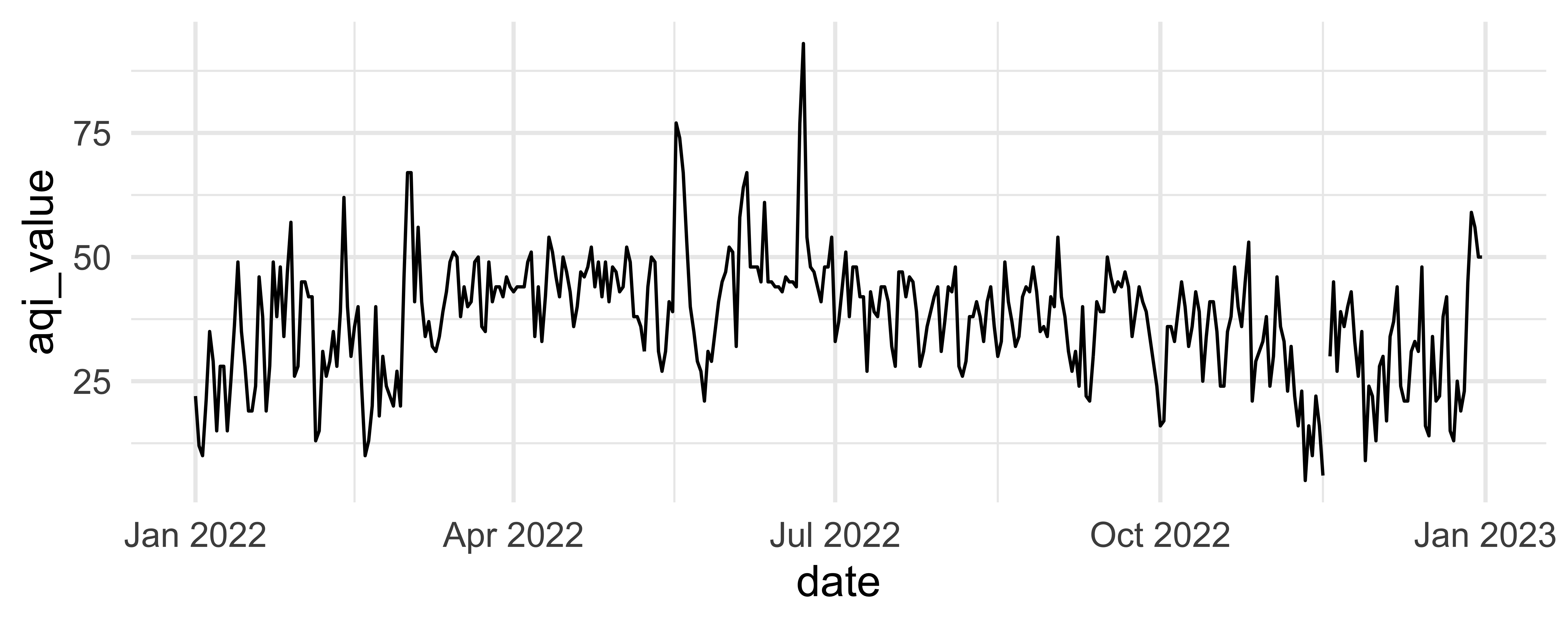
Improve
How would you improve this visualization?

Visualizing Durham AQI - v1
Recreate the following visualization.
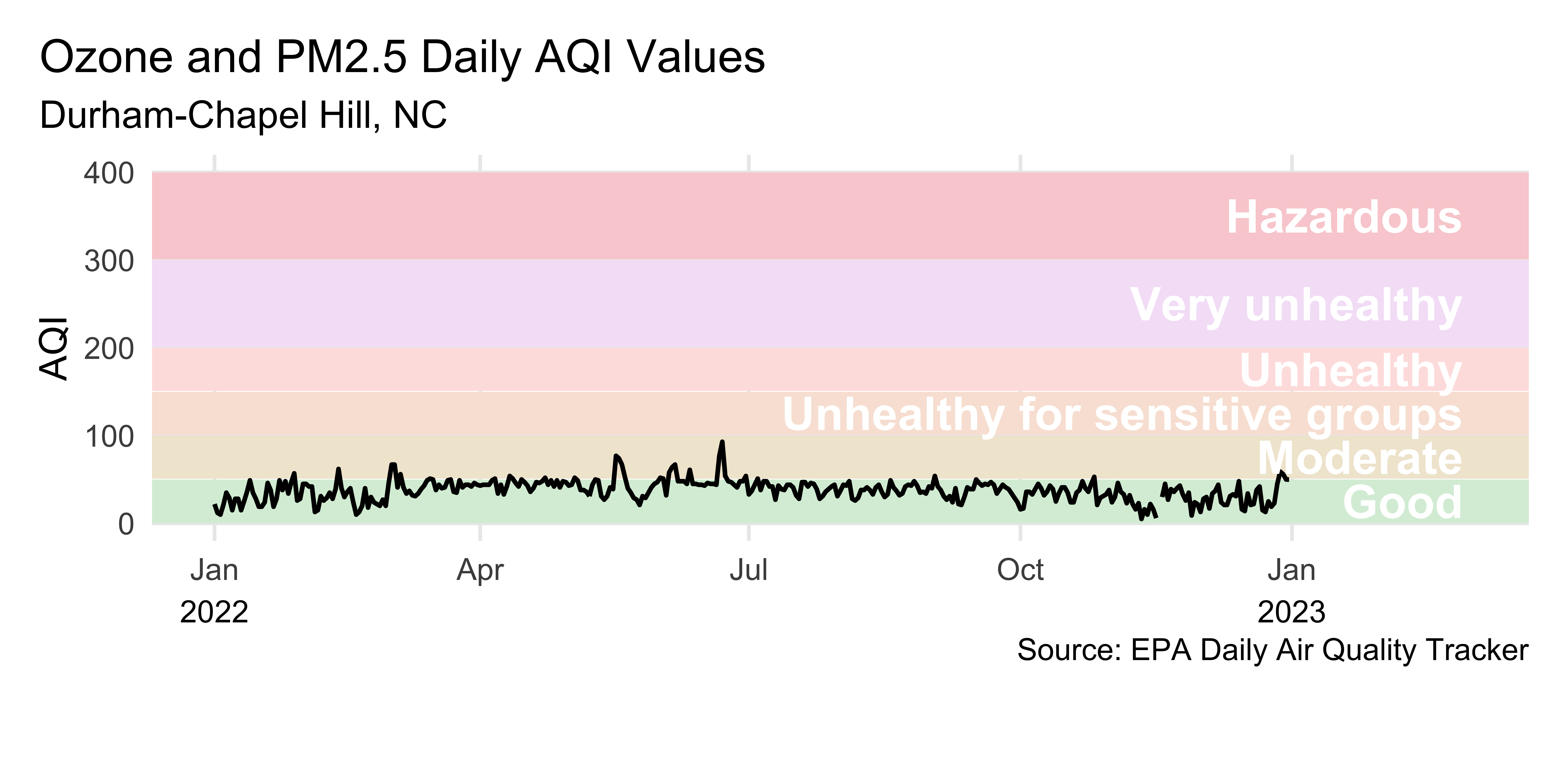
Visualizing Durham AQI - v2
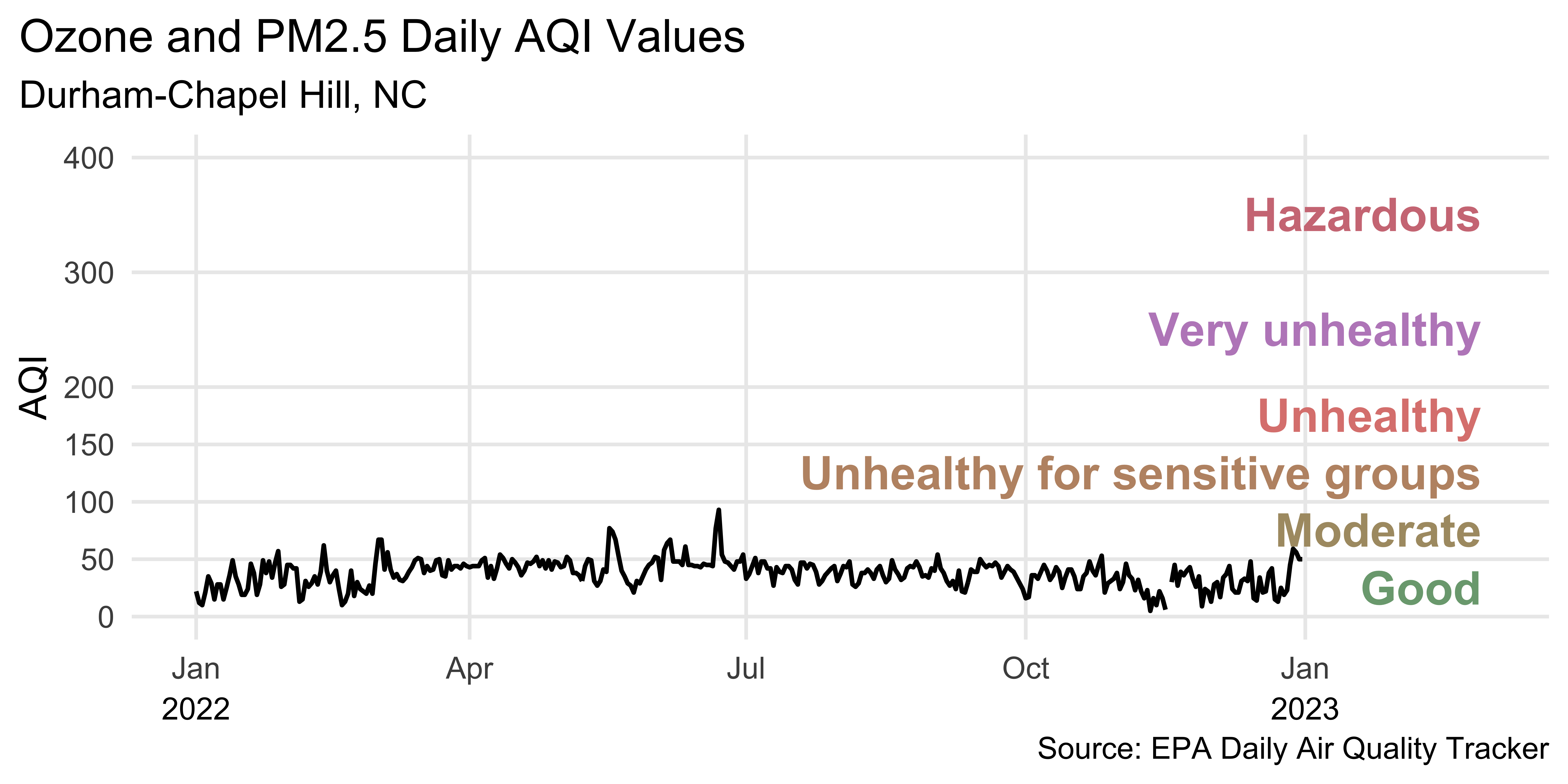
dch_2022 |>
ggplot(aes(x = date, y = aqi_value, group = 1)) +
geom_line(linewidth = 0.8) +
scale_x_date(
name = NULL, date_labels = "%b",
limits = c(ymd("2022-01-01"), ymd("2023-03-01"))
) +
scale_y_continuous(breaks = c(0, 50, 100, 150, 200, 300, 400)) +
geom_text(
data = aqi_levels,
aes(
x = ymd("2023-02-28"), y = aqi_mid,
label = level, color = darken(color, 0.3)
),
hjust = 1, size = 6, fontface = "bold"
) +
scale_color_identity() +
annotate(
geom = "text",
x = c(ymd("2022-01-01"), ymd("2023-01-01")), y = -80,
label = c("2022", "2023"), size = 4
) +
coord_cartesian(clip = "off", ylim = c(0, 400)) +
labs(
x = NULL, y = "AQI",
title = "Ozone and PM2.5 Daily AQI Values",
subtitle = "Durham-Chapel Hill, NC",
caption = "\nSource: EPA Daily Air Quality Tracker"
) +
theme(
plot.title.position = "plot",
panel.grid.minor.y = element_blank(),
panel.grid.minor.x = element_blank()
)Highlights
The lubridate package is useful for converting to dates from character strings in a given format, e.g.
mdy(),ymd(), etc.The colorspace package is useful for programmatically darkening / lightening colors
scale_x_date: Setdate_labelsas"%b %y"for month-2 digit year,"%D"for date format such as%m/%d/%y, etc. See help forstrptime()for more.scale_color_identity()orscale_fill_identity()can be useful when your data already represents aesthetic values that ggplot2 can handle directly. By default doesn’t produce a legend.
What’s missing?
What’s missing in this plot?

Filling in the gaps
Filling in the gaps - Code
dch_2022 |>
mutate(
impute = if_else(is.na(aqi_value), TRUE, FALSE),
impute = if_else(is.na(lead(aqi_value)), TRUE, impute),
aqi_value = if_else(is.na(aqi_value), (lag(aqi_value) + lead(aqi_value))/2, aqi_value)
) |>
ggplot(aes(x = date, y = aqi_value, group = 1)) +
geom_line(
aes(color = impute), show.legend = FALSE,
linewidth = 0.8
) +
scale_color_manual(values = c("black", "cornflowerblue")) +
labs(
x = NULL, y = "AQI",
title = "Ozone and PM2.5 Daily AQI Values",
subtitle = "Durham-Chapel Hill, NC",
caption = "\nSource: EPA Daily Air Quality Tracker"
)Calculating cumulatives
Cumulatives over time
When visualizing time series data, a somewhat common task is to calculate cumulatives over time and plot them
In our example we’ll calculate the number of days with “good” AQI (\(\le\) 50) and plot that value on the y-axis and the date on the x-axis
Calculating cumulatives
Step 1. Arrange your data
Calculating cumulatives
Step 2. Identify good days
dch_2022 |>
select(date, aqi_value) |>
filter(!is.na(aqi_value)) |>
arrange(date) |>
mutate(good_aqi = if_else(aqi_value <= 50, 1, 0))# A tibble: 364 × 3
date aqi_value good_aqi
<date> <dbl> <dbl>
1 2022-01-01 22 1
2 2022-01-02 12 1
3 2022-01-03 10 1
4 2022-01-04 21 1
5 2022-01-05 35 1
# ℹ 359 more rowsCalculating cumulatives
Step 3. Sum over time
dch_2022 |>
select(date, aqi_value) |>
filter(!is.na(aqi_value)) |>
arrange(date) |>
mutate(
good_aqi = if_else(aqi_value <= 50, 1, 0),
cumsum_good_aqi = cumsum(good_aqi)
)# A tibble: 364 × 4
date aqi_value good_aqi cumsum_good_aqi
<date> <dbl> <dbl> <dbl>
1 2022-01-01 22 1 1
2 2022-01-02 12 1 2
3 2022-01-03 10 1 3
4 2022-01-04 21 1 4
5 2022-01-05 35 1 5
# ℹ 359 more rowsPlotting cumulatives
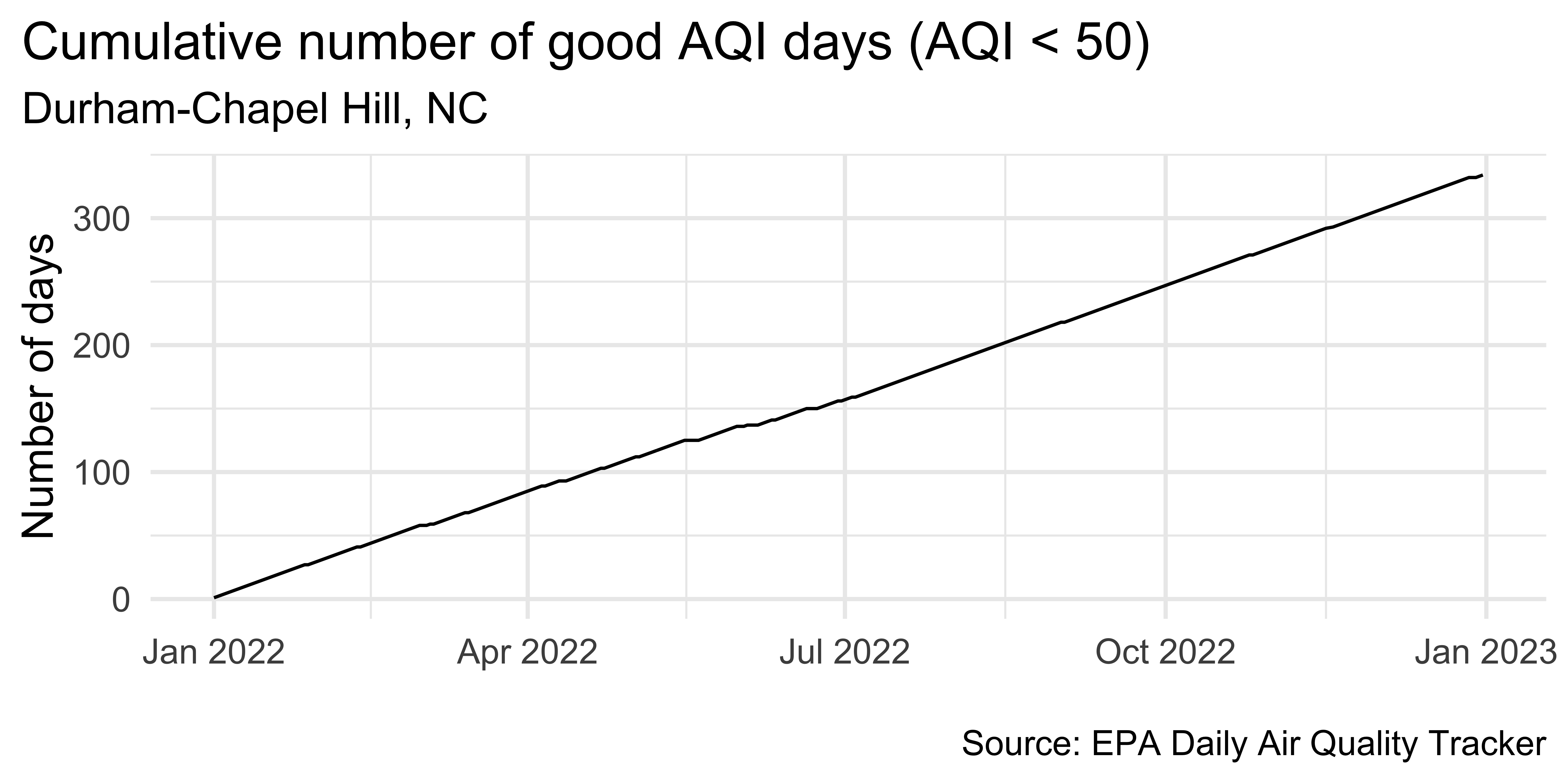
dch_2022 |>
select(date, aqi_value) |>
filter(!is.na(aqi_value)) |>
arrange(date) |>
mutate(
good_aqi = if_else(aqi_value <= 50, 1, 0),
cumsum_good_aqi = cumsum(good_aqi)
) |>
ggplot(aes(x = date, y = cumsum_good_aqi, group = 1)) +
geom_line() +
scale_x_date(date_labels = "%b %Y") +
labs(
x = NULL, y = "Number of days",
title = "Cumulative number of good AQI days (AQI < 50)",
subtitle = "Durham-Chapel Hill, NC",
caption = "\nSource: EPA Daily Air Quality Tracker"
) +
theme(plot.title.position = "plot")Detrending
Detrending
Detrending is removing prominent long-term trend in time series to specifically highlight any notable deviations
Let’s demonstrate using multiple years of AQI data
Multiple years of Durham-Chapel Hill data
/Users/mine/Desktop/teaching/Duke/sta313-s24/vizdata-s24/slides/06/data/durham-chapel-hill/ad_aqi_tracker_data-2016.csv
/Users/mine/Desktop/teaching/Duke/sta313-s24/vizdata-s24/slides/06/data/durham-chapel-hill/ad_aqi_tracker_data-2017.csv
/Users/mine/Desktop/teaching/Duke/sta313-s24/vizdata-s24/slides/06/data/durham-chapel-hill/ad_aqi_tracker_data-2018.csv
/Users/mine/Desktop/teaching/Duke/sta313-s24/vizdata-s24/slides/06/data/durham-chapel-hill/ad_aqi_tracker_data-2019.csv
/Users/mine/Desktop/teaching/Duke/sta313-s24/vizdata-s24/slides/06/data/durham-chapel-hill/ad_aqi_tracker_data-2020.csv
/Users/mine/Desktop/teaching/Duke/sta313-s24/vizdata-s24/slides/06/data/durham-chapel-hill/ad_aqi_tracker_data-2021.csv
/Users/mine/Desktop/teaching/Duke/sta313-s24/vizdata-s24/slides/06/data/durham-chapel-hill/ad_aqi_tracker_data-2022.csvReading multiple files
dch <- read_csv(dch_files, na = c(".", ""))
dch <- dch |>
janitor::clean_names() |>
mutate(
date = mdy(date),
good_aqi = if_else(aqi_value <= 50, 1, 0)
) |>
filter(!is.na(aqi_value)) |>
arrange(date) |>
mutate(cumsum_good_aqi = cumsum(good_aqi), .after = aqi_value)
dch# A tibble: 2,547 × 13
date aqi_value cumsum_good_aqi main_pollutant site_name site_id source
<date> <dbl> <dbl> <chr> <chr> <chr> <chr>
1 2016-01-01 32 1 PM2.5 Durham Arm… 37-063… AQS
2 2016-01-02 37 2 PM2.5 Durham Arm… 37-063… AQS
3 2016-01-03 45 3 PM2.5 Durham Arm… 37-063… AQS
4 2016-01-04 33 4 PM2.5 Durham Arm… 37-063… AQS
5 2016-01-05 27 5 PM2.5 Durham Arm… 37-063… AQS
# ℹ 2,542 more rows
# ℹ 6 more variables: x20_year_high_2000_2019 <dbl>,
# x20_year_low_2000_2019 <dbl>, x5_year_average_2015_2019 <dbl>,
# date_of_20_year_high <chr>, date_of_20_year_low <chr>, good_aqi <dbl>Plot trend since 2016
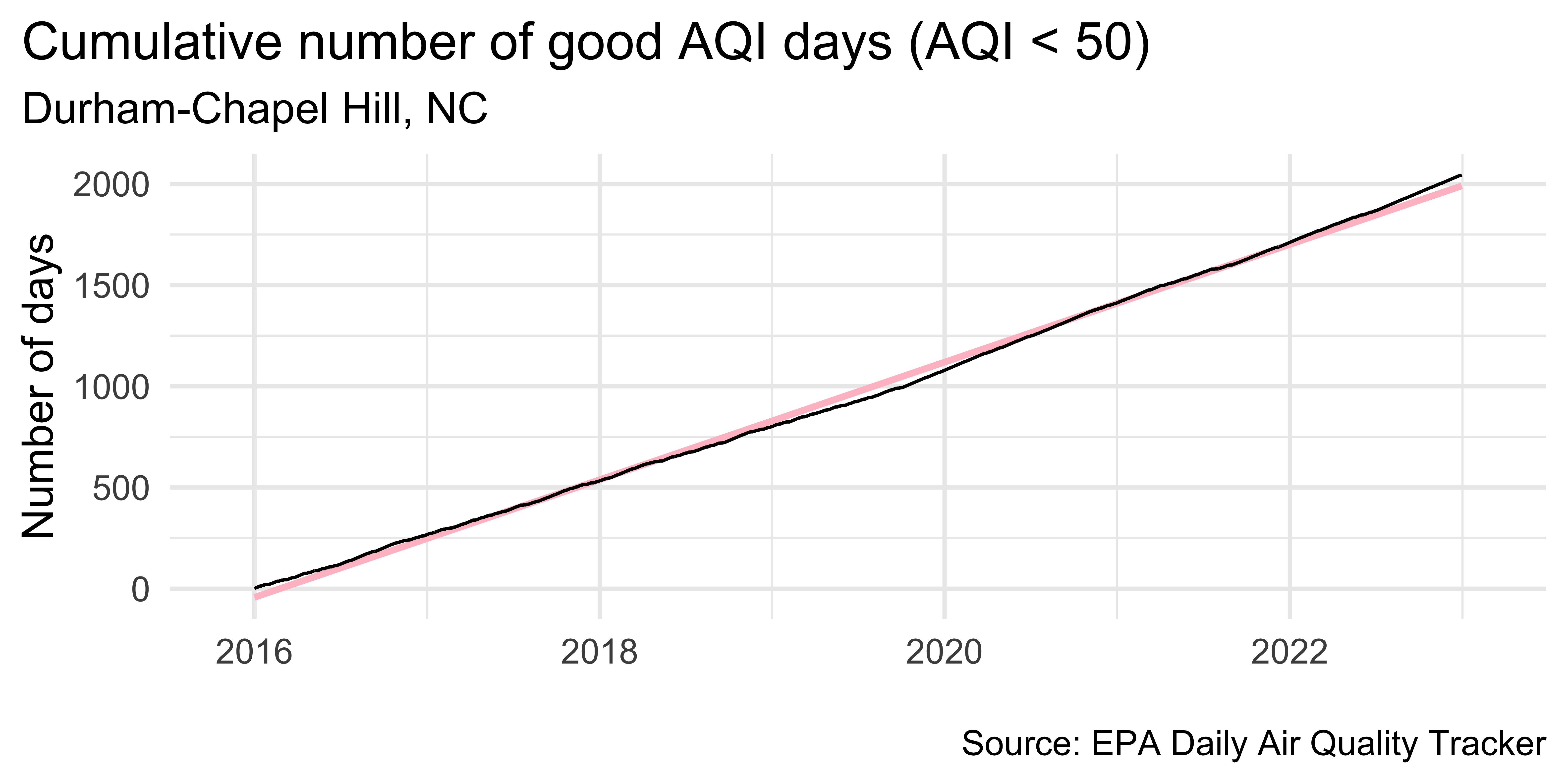
dch |>
ggplot(aes(x = date, y = cumsum_good_aqi, group = 1)) +
geom_smooth(method = "lm", color = "pink") +
geom_line() +
scale_x_date(
expand = expansion(mult = 0.07),
date_labels = "%Y"
) +
labs(
x = NULL, y = "Number of days",
title = "Cumulative number of good AQI days (AQI < 50)",
subtitle = "Durham-Chapel Hill, NC",
caption = "\nSource: EPA Daily Air Quality Tracker"
) +
theme(plot.title.position = "plot")`geom_smooth()` using formula = 'y ~ x'Detrend
Step 1. Fit a simple linear regression
Detrend
Step 2. Augment the data with model results (using broom::augment())
# A tibble: 2,547 × 8
cumsum_good_aqi date .fitted .resid .hat .sigma .cooksd .std.resid
<dbl> <date> <dbl> <dbl> <dbl> <dbl> <dbl> <dbl>
1 1 2016-01-01 -42.8 43.8 0.00157 25.4 0.00234 1.73
2 2 2016-01-02 -42.0 44.0 0.00157 25.4 0.00236 1.74
3 3 2016-01-03 -41.3 44.3 0.00156 25.4 0.00238 1.74
4 4 2016-01-04 -40.5 44.5 0.00156 25.4 0.00240 1.75
5 5 2016-01-05 -39.7 44.7 0.00156 25.4 0.00242 1.76
# ℹ 2,542 more rowsDetrend
Step 3. Divide the observed value of cumsum_good_aqi by the respective value in the long-term trend (i.e., .fitted)
# A tibble: 2,547 × 9
cumsum_good_aqi date .fitted ratio .resid .hat .sigma .cooksd
<dbl> <date> <dbl> <dbl> <dbl> <dbl> <dbl> <dbl>
1 1 2016-01-01 -42.8 -0.0233 43.8 0.00157 25.4 0.00234
2 2 2016-01-02 -42.0 -0.0476 44.0 0.00157 25.4 0.00236
3 3 2016-01-03 -41.3 -0.0727 44.3 0.00156 25.4 0.00238
4 4 2016-01-04 -40.5 -0.0989 44.5 0.00156 25.4 0.00240
5 5 2016-01-05 -39.7 -0.126 44.7 0.00156 25.4 0.00242
# ℹ 2,542 more rows
# ℹ 1 more variable: .std.resid <dbl>Visualize detrended data
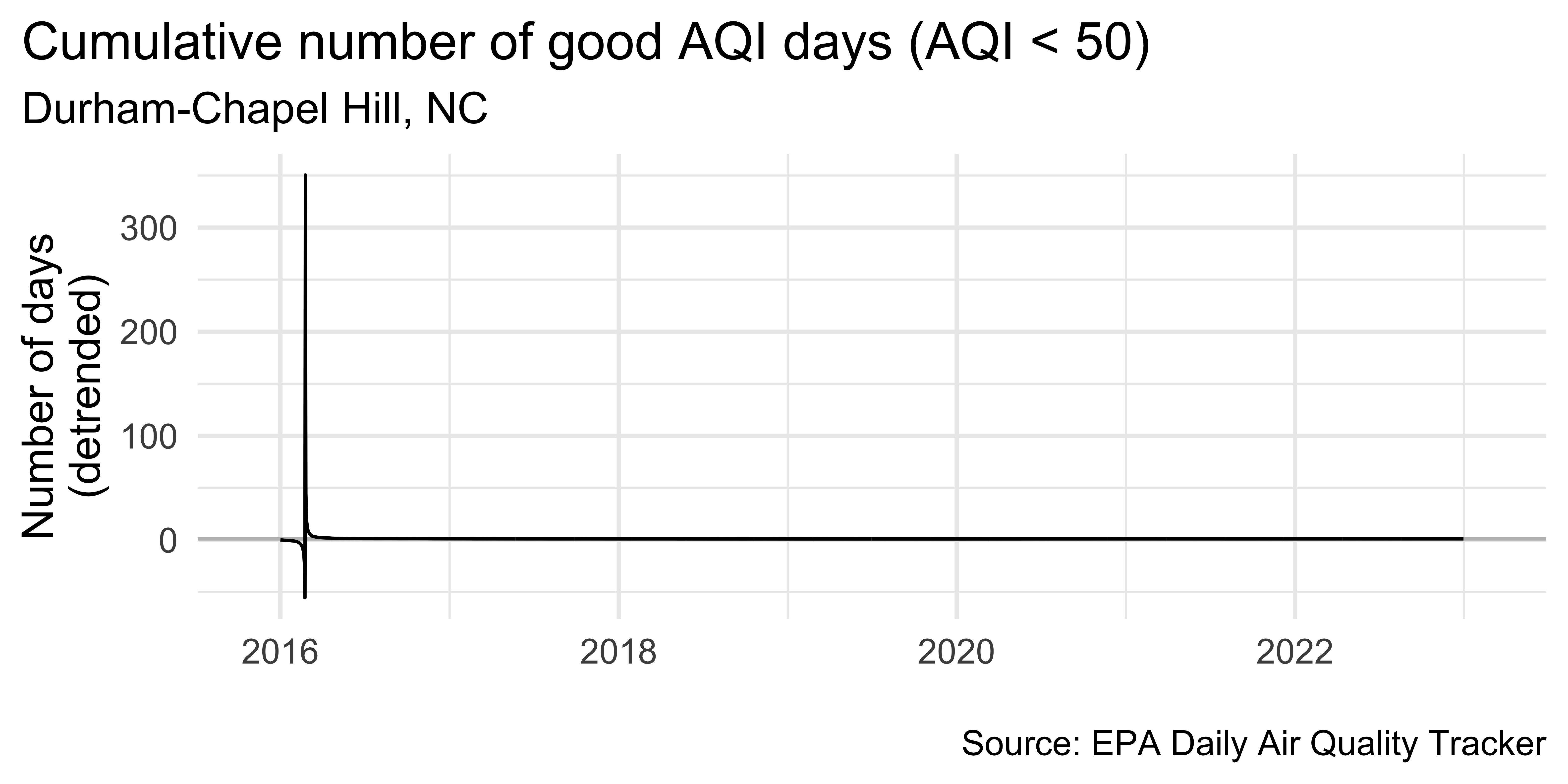
dch_aug |>
ggplot(aes(x = date, y = ratio, group = 1)) +
geom_hline(yintercept = 1, color = "gray") +
geom_line() +
scale_x_date(
expand = expansion(mult = 0.07),
date_labels = "%Y"
) +
labs(
x = NULL, y = "Number of days\n(detrended)",
title = "Cumulative number of good AQI days (AQI < 50)",
subtitle = "Durham-Chapel Hill, NC",
caption = "\nSource: EPA Daily Air Quality Tracker"
) +
theme(plot.title.position = "plot")Air Quality in Durham
barely anything interesting happening!
let’s look at data from somewhere with a bit more “interesting” air quality data…
Read in multiple years of SF data
sf <- read_csv(sf_files, na = c(".", ""))
sf <- sf |>
janitor::clean_names() |>
mutate(
date = mdy(date),
good_aqi = if_else(aqi_value <= 50, 1, 0)
) |>
filter(!is.na(aqi_value)) |>
arrange(date) |>
mutate(cumsum_good_aqi = cumsum(good_aqi), .after = aqi_value)
sf# A tibble: 2,557 × 13
date aqi_value cumsum_good_aqi main_pollutant site_name site_id source
<date> <dbl> <dbl> <chr> <chr> <chr> <chr>
1 2016-01-01 32 1 PM2.5 Durham Arm… 37-063… AQS
2 2016-01-02 37 2 PM2.5 Durham Arm… 37-063… AQS
3 2016-01-03 45 3 PM2.5 Durham Arm… 37-063… AQS
4 2016-01-04 33 4 PM2.5 Durham Arm… 37-063… AQS
5 2016-01-05 27 5 PM2.5 Durham Arm… 37-063… AQS
# ℹ 2,552 more rows
# ℹ 6 more variables: x20_year_high_2000_2019 <dbl>,
# x20_year_low_2000_2019 <dbl>, x5_year_average_2015_2019 <dbl>,
# date_of_20_year_high <chr>, date_of_20_year_low <chr>, good_aqi <dbl>Plot trend since 2016
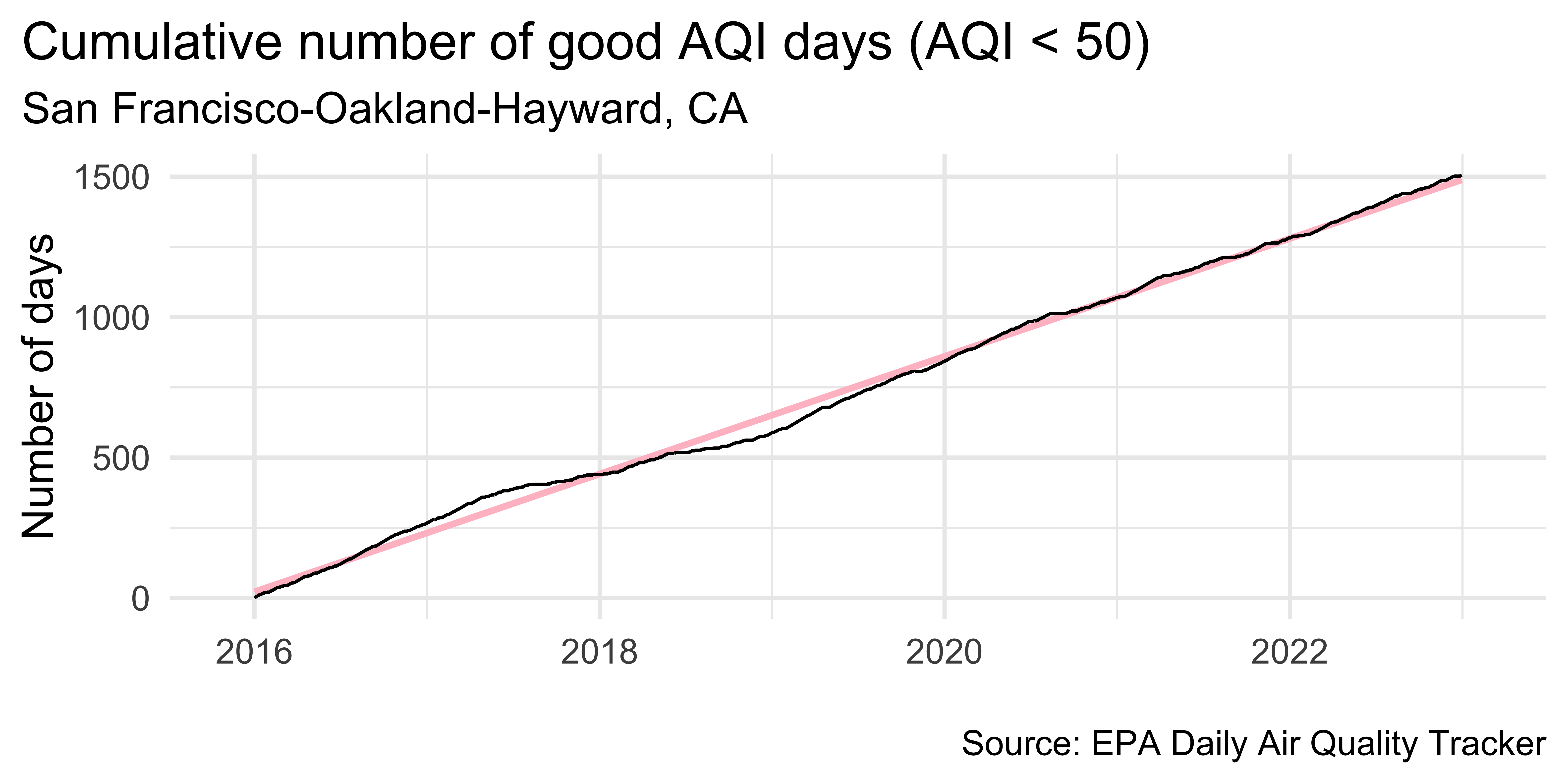
sf |>
ggplot(aes(x = date, y = cumsum_good_aqi, group = 1)) +
geom_smooth(method = "lm", color = "pink") +
geom_line() +
scale_x_date(
expand = expansion(mult = 0.07),
date_labels = "%Y"
) +
labs(
x = NULL, y = "Number of days",
title = "Cumulative number of good AQI days (AQI < 50)",
subtitle = "San Francisco-Oakland-Hayward, CA",
caption = "\nSource: EPA Daily Air Quality Tracker"
) +
theme(plot.title.position = "plot")`geom_smooth()` using formula = 'y ~ x'Detrend
- Fit a simple linear regression
Visualize detrended data
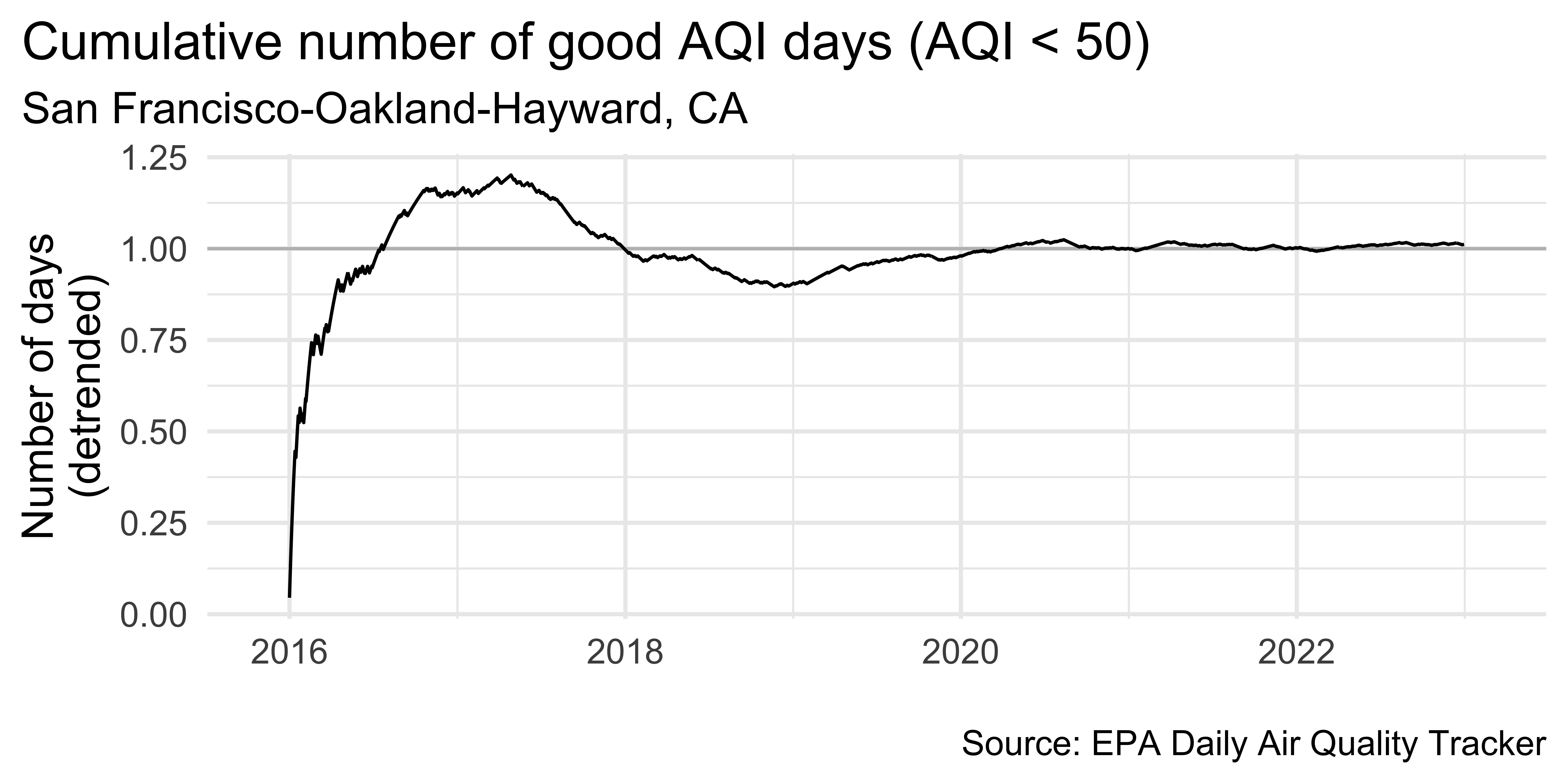
sf_aug |>
ggplot(aes(x = date, y = ratio, group = 1)) +
geom_hline(yintercept = 1, color = "gray") +
geom_line() +
scale_x_date(
expand = expansion(mult = 0.07),
date_labels = "%Y"
) +
labs(
x = NULL, y = "Number of days\n(detrended)",
title = "Cumulative number of good AQI days (AQI < 50)",
subtitle = "San Francisco-Oakland-Hayward, CA",
caption = "\nSource: EPA Daily Air Quality Tracker"
) +
theme(plot.title.position = "plot")Detrending
In step 2 we fit a very simple model
Depending on the complexity you’re trying to capture you might choose to fit a much more complex model
You can also decompose the trend into multiple trends, e.g. monthly, long-term, seasonal, etc.
